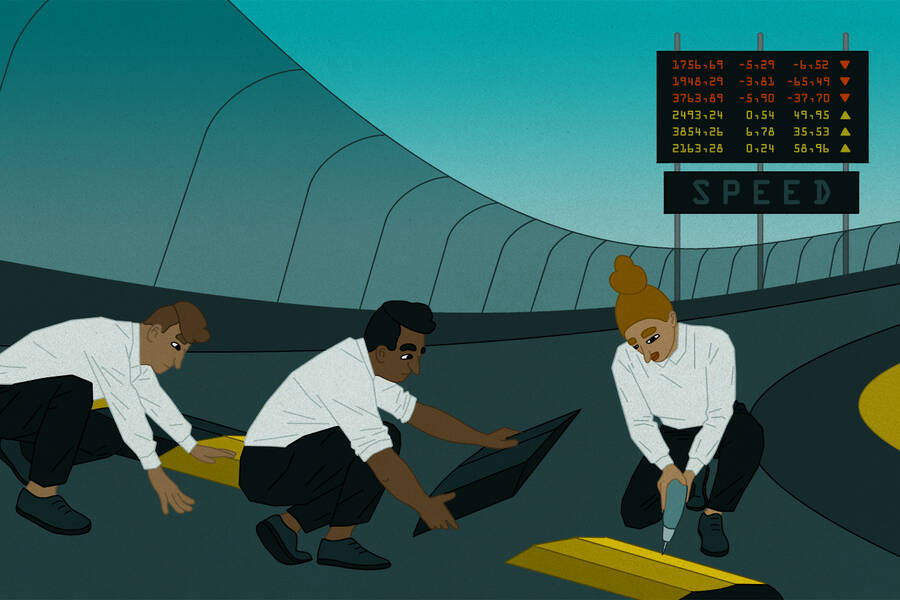Finance & Accounting Feb 24, 2022
Meme Trading Is Not Dead—It Will Continue to Rile Markets
Investors are going to continue using social media to gain a trading edge.

Yevgenia Nayberg
Of all the trends that have emerged out of the pandemic, one of the most watched in the financial arena was the rise of meme stocks. Online traders, often young and inexperienced, banded together via social media platforms, such as Reddit’s r/wallstreetbets, in hopes of turning a quick profit. As a collective force, meme traders focused on two stocks in particular that reached almost a cult status: video game retailer GameStop Corp. and theater chain AMC Entertainment Holdings.
For the year before its meme craze started, GameStop’s stock was trading at around $4.80; then the meme speculation drove its price to an all-time high of $348.50, and today it is trading at around $120. Before its meme mania, AMC’s average trading price was $5.76; then AMC reached its meme high of $72.62, and today it trades for around $18.00.
Both GameStop and AMC were financially weak, as reflected in their stock prices of around $5 before the meme craze started. These low prices allowed the initial meme traders to get in cheap, promote the stocks, and then reap enormous profits along the way.
GameStop and AMC still have very high stock prices relative to their pre-meme valuations. In fact, GameStop’s financials are worse today than they were before the meme craze, its net income continues to be negative, and revenues have fallen. Nevertheless, its share price today is a crazy 25 times what it was before the meme speculation. While AMC’s bottom line has slowly shown improvement since the beginning of the pandemic, financially it is still substantially below the period before that. Yet, AMC’s stock price today is three times what it was.
These numbers indicate that investor interest in these two stocks remains high and that not all the meme traders have cashed out, having internalized the hype, which helps keep these stock prices elevated. However, the decline in GameStop’s and AMC’s stock prices from their lofty highs, even before the current market sell-off, has prompted multiple observers to declare the end of the meme phenomenon. Sounding the death knell for meme trading based on this evidence, though, is premature.
What Memes Really Mean
To explore this phenomenon, we need to consider what meme stocks actually are. They have been defined in multiple ways, most revolving around gaining a following via social media and other online platforms and achieving a status where they “catch fire” with multiple individual investors, sending their share prices skyrocketing and breaking their bond with sound fundamentals. While such attributes may have defined meme stocks in the past, going forward, explosive price movements due to collective action may no longer be the norm, although prices may still be divorced from reality. Rather, the more enduring aspect of meme stocks, and any meme financial asset, is using social media as the main information source to gain a purposed trading edge. This is the defining characteristic for meme trading.
The Rise of Robinhood
Through 2020 and 2021, meme stocks introduced a new generation of traders and speculators to trading, with many of them using Robinhood Markets as their trading platform, which disrupted the brokerage sector because it was easy to use, fun, and free. As Forbes observers noted, “Robinhood’s secret sauce proved especially compelling during the Covid-19 pandemic, with Americans locked indoors and eager for any way to keep occupied.”
As the trading platform of choice among original meme traders, Robinhood saw explosive growth through most of 2021, but also faced criticism for gamifying stock and options trading, such as for featuring only some of the more easily understood indicators used in trading and showing a burst of confetti on the screen when a trade was made. In fact, criticisms against Robinhood may be among the reasons why the Securities and Exchange Commission (SEC) is expected to announce policy changes in response to the wild ride in meme stocks.
We cannot infer from Robinhood’s current problems that meme trading is dead; it could just be hibernating.
— Phillip Braun
More telling, however, is a recent study that illustrated how “heightened attention-driven buying” led to herding behavior, revealing “more concentrated trading” by Robinhood users compared with other retail investors. The result, the researchers said, was that Robinhood users experienced negative average returns of approximately 5 percent over the month after a purchase, while more “extreme herding events” were followed by negative average returns of almost 20 percent.
Although at the end of 2021 Robinhood’s active users numbered 22.5 million, its trading volume declined in the latter half of that year, and it had substantial negative earnings throughout the year—all of which brought its stock valuation down by 85 percent from its high. It is not clear if the meme traders have left Robinhood, and if they have, why. By the same token, we cannot infer from Robinhood’s current problems that meme trading is dead; it could just be hibernating.
Beyond the Meme Stock
Today, internet sites such as r/wallstreetbets clearly are not the influence they once were, and this might appear at first glance to indicate the death of meme trading, but it is nothing of the sort. Perhaps the original spurt in meme stocks was nothing more than a pump-and-dump scheme by some r/wallstreetbets participants, and some or many meme traders may have learned their lesson and left the site. It also could be evidence of fragmentation among social-media sites that compete for traders’ attention. For example, many stocks now have their own subreddit sites. Discord, an alternative to Redditt, has increased in popularity. Furthermore, there are now websites that allow speculators to monitor the social-media attention a stock is receiving without actually looking on social media. As collective energy becomes more fragmented, meme traders may be less likely to act en masse; as a result, we may not see the big punch jumps in stocks as witnessed in the past in AMC and GameStop.
But if we accept the premise that meme trading is not dead, but merely changing, where might we see this activity emerge? We return to the baseline definition of using social-media information. There are plenty of traders who continue to trade based off social media as their edge who are now focusing on other tradable assets. We’ve seen meme activity in the special purpose acquisition company (SPAC) market, a particularly low-return risky venture sector for retail investors, with telltale signs of meme status, in particular for Trump Media’s SPAC, which has jumped 700 percent since its listing, and previous meme signs for many other SPACs, such as Virgin Galactic, whose price jumped, after its IPO, by 460 percent at its high, but has since come crashing back to earth.
Meme traders have also shifted their focus to non-fungible tokens (NFTs), which might be thought of as a cross between a graphic and a cryptocurrency. These unique assets (hence the term “non-fungible”) have amassed a marketplace worth an estimated $40 billion. Because NFTs have no fundamental value, trading in them is all based on what is being broadcast on social media. Some NFTs prices have soared, such as the CryptoPunk NFTs, which were originally given away for free and now trade for around $160,000 apiece, or the Bored Apes, which last April were trading for around $200 and are now trading for $84,000. While this shift to NFTs may mean less attention for meme stocks, at least one of the original names is getting in on the NFT action. GameStop reportedly is seeking to become a player in both NFTs and cryptocurrency technology.
Implications for the Market
Meme traders are your usual out-to-make-a-quick-buck investors. There is nothing unusual about them, other than using social media to help pick stocks and, unfortunately for some, to promote them to push up prices. This type of trading scheme is not going to disappear. With their short attention spans and desire to find the next opportunity, meme traders will no doubt emerge in future investing hot spots. While some meme traders have made money, some of their actions have burned many more. How profitable or successful meme traders’ activities will be in the futures is anyone’s guess. As social media and market opportunities evolve side by side, meme trading is not going to disappear—it will just move on to the next big investment idea.
*
This article originally appeared in Forbes.



